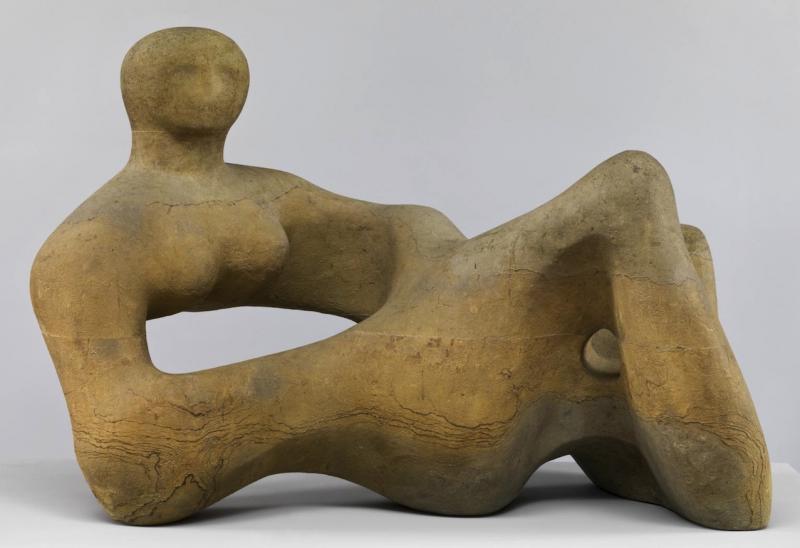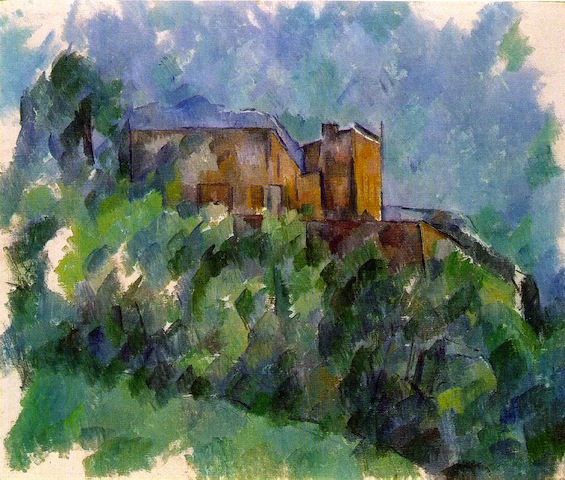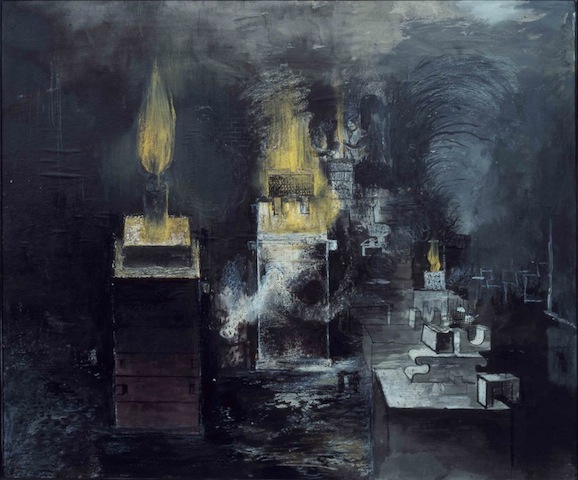Kenneth Clark: Looking for Civilisation, Tate Britain | reviews, news & interviews
Kenneth Clark: Looking for Civilisation, Tate Britain
Kenneth Clark: Looking for Civilisation, Tate Britain
An exhibition that offers an insight into the man who educated a nation about art

Lord, I confess I have never seen Kenneth Clark’s epic 13-part series Civilisation.
But having read him, including the book based on that acclaimed 1969 series, I can vouch that his plummy, chummy prose goes down a treat. Authoritative yet deeply personable, Clark proves a breezily erudite, thoroughly engaging guide to the highpoints of Western art and culture. If "conservative", "patrician" and of course "Eurocentric" are considered problematic, then we may at least counter with "witty", "urbane" and "eloquent".
When the Marxist critic John Berger wrote and presented his four-part BBC series Ways of Seeing in 1972, just three years after Clark’s Civilisation: A Personal View aired on the same channel, Berger skewered what was strongly felt to be the older critic’s complacent – read Edwardian – world-view. A dominant ideology was being laid bare in an eviscerating critique. Yet as much as he’s been attacked and/or caricatured, Clark’s work remains vivid with striking insights, such as those of One Hundred Details, his book examining and comparing often overlooked details of great paintings in the National Gallery, where he served as its youngest director, appointed when he was 30, from 1933.
Or you could just say he had a well-developed sense of noblesse oblige
You could argue that his aristocratic world-view was always underpinned by a liberal, democratising sensibility, the latter a word that keeps cropping up in recent “corrective” writing about him – he, after all, wanted to reach out and educate the people, and this extended to the way he ran the National Gallery, opening on FA Cup Final day, for instance, to attract bigger crowds. Or you could just say he had a well-developed sense of noblesse oblige, and there’s very little that’s genuinely democratic about that. Yet through his work we see clearly the possession of a humane and humanising set of beliefs, which perfectly understandably leads to a distrust of clever Left ideologies with their dehumanising “systems”, and this makes his work very appealing, very sympathetic.
This exhibition gives a us a flavour of the man not through his writings – though thankfully we get snatches of writing too – but through the art he collected. We get a glimpse of the man through the living artists he commissioned and supported, often very generously by securing mortgages on homes and paying salaries, with Graham Sutherland and Victor Pasmore two such beneficiaries of Clark’s largesse. It shows the works he purchased for the National Gallery, and the paintings later commissioned when he set up the War Artists Advisory Committee, where he appointed British artists he admired to depict devastation and stoicism on the home front (and perhaps also to save them getting slaughtered in battle). It also exposes several clumsy misattributions, where he purchased work confident they were by the hand of Michelangelo or Giorgione, when they were later revealed to be by minor artists, the latter misattribution for a purchase for the National Gallery even causing questions to be asked in Parliament arising from the irresponsible use of public money. Clark had an eye, but it was certainly far from infallible.
The first gallery shows some of the paintings that Clark grew up with, though there is little that can be remotely described as avant-garde. His idly rich father, Kenneth M Clark, who’d inherited his wealth through the family textile business (Clark junior’s great-great-grandfather was the inventor of the cotton spool), decorated his splendid pile, the country seat of Sudbourne Hall in Suffolk, with Victorian paintings, the more notable among them by Landseer and Millais. And he commissioned portraits of his son, one by John Lavery, another by Charles Sims, which were largely sentimental visions of an Edwardian boyhood.
 But Clark was also exposed to the striking “decadent” prints of Aubrey Beardsley, the Punch cartoons of Charles Keene (which he copied assiduously as a child) and the Japanese woodcuts of outstanding Ukiyo-e artists such as Hokusai and Utamaro, whose flat, patterned surfaces are important in understanding developments in the French 19th-century avant-garde. And as a student at Oxford, Clark also came under the influence of Roger Fry, the Bloomsbury artist and critic who did more than anyone to promote Impressionism and Post-Impressionism in the UK. From him he may have inherited his love of Cézanne, and Clark later bought about 30 or so drawings by the French artist “for less than the price of a motor car”, some of which are on view here. The exhibition ends with a late Cézanne, the 1904 Le Château Noir (pictured above), hanging on a wall on its own as if to redeem the less persuasive purchases.
But Clark was also exposed to the striking “decadent” prints of Aubrey Beardsley, the Punch cartoons of Charles Keene (which he copied assiduously as a child) and the Japanese woodcuts of outstanding Ukiyo-e artists such as Hokusai and Utamaro, whose flat, patterned surfaces are important in understanding developments in the French 19th-century avant-garde. And as a student at Oxford, Clark also came under the influence of Roger Fry, the Bloomsbury artist and critic who did more than anyone to promote Impressionism and Post-Impressionism in the UK. From him he may have inherited his love of Cézanne, and Clark later bought about 30 or so drawings by the French artist “for less than the price of a motor car”, some of which are on view here. The exhibition ends with a late Cézanne, the 1904 Le Château Noir (pictured above), hanging on a wall on its own as if to redeem the less persuasive purchases.
The paintings, drawings and sculptures that Clark bought for his private enjoyment, for his homes in Hampstead and at Saltwood in Kent, a neo-gothic castle painted by a young Turner, range from “A Pair of White Busts of Mongolians” – an 18th-century pair of decorative busts of a male and female made by the London-based Bow Porcelain Factory, a copy Degas made of a painting formerly attributed to Gentile Bellini, and an enormous Recumbent Figure (main picture) by his beloved Henry Moore. And among some private commissions are a dinner service designed by Duncan Grant and Vanessa Bell, portraying, as second-rate illustrations on dinner plates, notable women of history. It is, one might say, a mixed bag. But Clark was loyal and supportive to those artists he liked, their friendship, one feels, as important as a belief in their natural talents. You could say that’s a positive testament to his character.
 Where the exhibition really takes off is towards the end – especially in the two rooms largely devoted to Sutherland and John Piper, their depictions of the Blitz being among the strongest wartime images of British soil, though Piper’s work is undoubtedly more picturesque; while among the most darkly seductive of Sutherland’s paintings is his depiction of a foundry (pictured above: A Foundry, 1941-42; © Tate) an image of dark, satanic millery if every there was one, yet possessing majestic beauty too (note: it doesn't reproduce well). Notably, there are no Bacons, an artist whose nihilism naturally sat uneasily with Clark's romantic, essentially humanistic vision.
Where the exhibition really takes off is towards the end – especially in the two rooms largely devoted to Sutherland and John Piper, their depictions of the Blitz being among the strongest wartime images of British soil, though Piper’s work is undoubtedly more picturesque; while among the most darkly seductive of Sutherland’s paintings is his depiction of a foundry (pictured above: A Foundry, 1941-42; © Tate) an image of dark, satanic millery if every there was one, yet possessing majestic beauty too (note: it doesn't reproduce well). Notably, there are no Bacons, an artist whose nihilism naturally sat uneasily with Clark's romantic, essentially humanistic vision.
See this exhibition – stay awhile among the television monitors in the penultimate gallery and you’ll leave on a high. Perhaps you’ll want to open one of Clark’s books. Or, like me, watch Civilisation in its entirety.
- Kenneth Clark: Looking for Civilisation at Tate Britain until 20 August
Explore topics
Share this article
Add comment
The future of Arts Journalism
You can stop theartsdesk.com closing!
We urgently need financing to survive. Our fundraising drive has thus far raised £49,000 but we need to reach £100,000 or we will be forced to close. Please contribute here: https://gofund.me/c3f6033d
And if you can forward this information to anyone who might assist, we’d be grateful.

Subscribe to theartsdesk.com
Thank you for continuing to read our work on theartsdesk.com. For unlimited access to every article in its entirety, including our archive of more than 15,000 pieces, we're asking for £5 per month or £40 per year. We feel it's a very good deal, and hope you do too.
To take a subscription now simply click here.
And if you're looking for that extra gift for a friend or family member, why not treat them to a theartsdesk.com gift subscription?
more Visual arts
 'We are bowled over!' Thank you for your messages of love and support
Much-appreciated words of commendation from readers and the cultural community
'We are bowled over!' Thank you for your messages of love and support
Much-appreciated words of commendation from readers and the cultural community
 Folkestone Triennial 2025 - landscape, seascape, art lovers' escape
Locally rooted festival brings home many but not all global concerns
Folkestone Triennial 2025 - landscape, seascape, art lovers' escape
Locally rooted festival brings home many but not all global concerns
 Sir Brian Clarke (1953-2025) - a personal tribute
Remembering an artist with a gift for the transcendent
Sir Brian Clarke (1953-2025) - a personal tribute
Remembering an artist with a gift for the transcendent
 Emily Kam Kngwarray, Tate Modern review - glimpses of another world
Pictures that are an affirmation of belonging
Emily Kam Kngwarray, Tate Modern review - glimpses of another world
Pictures that are an affirmation of belonging
 Kiefer / Van Gogh, Royal Academy review - a pairing of opposites
Small scale intensity meets large scale melodrama
Kiefer / Van Gogh, Royal Academy review - a pairing of opposites
Small scale intensity meets large scale melodrama
 Jenny Saville: The Anatomy of Painting, National Portrait Gallery review - a protégé losing her way
A brilliant painter in search of a worthwhile subject
Jenny Saville: The Anatomy of Painting, National Portrait Gallery review - a protégé losing her way
A brilliant painter in search of a worthwhile subject
 Abstract Erotic, Courtauld Gallery review - sculpture that is sensuous, funny and subversive
Testing the boundaries of good taste, and winning
Abstract Erotic, Courtauld Gallery review - sculpture that is sensuous, funny and subversive
Testing the boundaries of good taste, and winning
 Edward Burra, Tate Britain review - watercolour made mainstream
Social satire with a nasty bite
Edward Burra, Tate Britain review - watercolour made mainstream
Social satire with a nasty bite
 Ithell Colquhoun, Tate Britain review - revelations of a weird and wonderful world
Emanations from the unconscious
Ithell Colquhoun, Tate Britain review - revelations of a weird and wonderful world
Emanations from the unconscious
 Rachel Jones: Gated Canyons, Dulwich Picture Gallery review - teeth with a real bite
Mouths have never looked so good
Rachel Jones: Gated Canyons, Dulwich Picture Gallery review - teeth with a real bite
Mouths have never looked so good
 Yoshitomo Nara, Hayward Gallery review - sickeningly cute kids
How to make millions out of kitsch
Yoshitomo Nara, Hayward Gallery review - sickeningly cute kids
How to make millions out of kitsch
 Hamad Butt: Apprehensions, Whitechapel Gallery review - cool, calm and potentially lethal
The YBA who didn’t have time to become a household name
Hamad Butt: Apprehensions, Whitechapel Gallery review - cool, calm and potentially lethal
The YBA who didn’t have time to become a household name

Comments
"Yet through his work we see